FALLS CITY, Neb. (KMTV) — The world of weather forecasting would not be anywhere near where it is today without two institutions that relied on weather forecasts, agriculture, and aviation. From the Wright Brother's first flight in the 1900s to today's aviation empire, meteorology has played a substantial role in getting the industry to where it is today. From providing forecasts to flights to planes recording weather data in the upper atmosphere, both have worked together to create a safe journey for flyers.
Unfortunately, we could not get where we are today in-flight safety without hitting several speed bumps. Throughout the first several decades of aviation, crashes due to weather were somewhat familiar, particularly from flying into thunderstorms. The mounting number of accidents from weather brought pressure on the meteorological community to upgrade forecasting processes.
One of these crashes happened on August 6, 1966, near Falls City. Braniff Airlines Flight 250 flew into a squall line of thunderstorms and crashed in a soybean field, killing all 42 people on board. To this day, it is Nebraska's deadliest aviation disaster. In this installment of This Week in Weather History, let's look back at the history of Flight 250, the fateful August night, and the lessons learned from the crash.
BRANIFF AIRLINES & FLIGHT 250
In the late 1920s, brothers Paul and Thomas Braniff founded a singular airline flight from Oklahoma City to Tulsa. Soon, the brothers founded Braniff Airlines in 1930. The company gradually expanded throughout the Midwest during the 1930s, capitalizing on the air mail industry. During World War II, the airline gave some planes to the army, as well as opened up their buildings in Dallas to use as training places. Their reward for this was the expansion of their airline into Latin America, whereby in the 1950s they had flights from Chicago to Buenos Aires. On August 16, 1952, Braniff Airlines purchased another airline with hubs across the Midwest to the South. This is when Braniff began flying to Kansas City, Omaha, and Minneapolis.

By 1954, the original Braniff brothers were no longer with the company. Paul Braniff left in 1935 to pursue other opportunities. While tragically Thomas Braniff was killed in a plane crash outside of Shreveport, Louisiana, in 1954. Upon his death, ownership of Braniff Airlines went to the then-vice president, who ran the company for the next 9 years. In 1965, Braniff Airlines was acquired by the Dallas-based Greatamerica Corporation. The new CEO had bold new ideas on how to put Braniff on the map.
"The end of the Plain Plane" was the first major marketing strategy employed by Braniff to attract a wider consumer base. The idea was to paint planes in various colors such as blue, orange, and brown. As this ad from 1965 shows. Braniff also brought changes to flight attendants, now renamed as hostesses. The hostesses would begin the flight in multiple layers of clothing with a space helmet, but during the ride, the women would gradually strip down into fewer clothes. Called the "air strip", the controversial ad campaign brought eyes to Braniff Airlines.

This was the state of the company in 1966, a complete rebranding, as well as expanding their routes. In 1961, the airline purchased a new type of plane created by the British Airways Corporation a year prior, the BAC 1-11. This new plane was part of a newer class of airliners which instead of going on long routes with lots of cargo, was designed for shorter-term flights with fewer passengers. The BAC 1-11s could hold up to 63 passengers, with 24 first-class options.
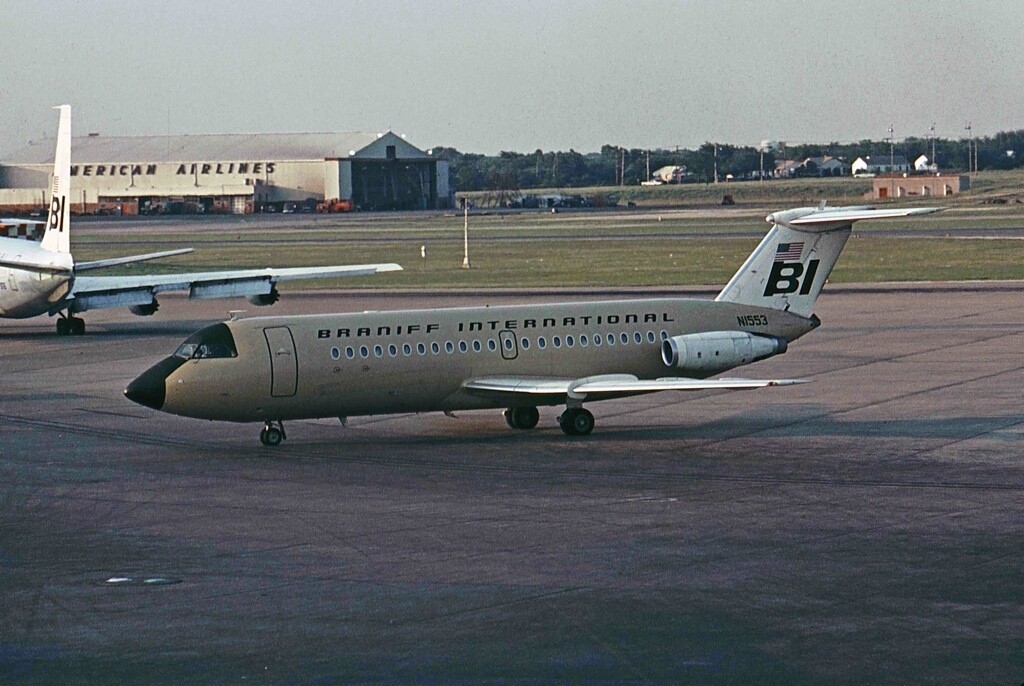
On December 8, 1965, one of the BAC 1-11's became Flight 250. Flight 250 had a particular route it took. Starting in New Orleans at 6:30 p.m., it would fly to stops in Shreveport, LA; Fort Smith, AR; Tulsa, OK; Kansas City, MO; Omaha, NE; and arriving in Minneapolis just before 2 a.m. By August 1966, the plane was very new, only having 2,307 flight hours.

AUGUST 6, 1966: THE FATEFUL FLIGHT
On August 6, Flight 250 was getting ready to depart from New Orleans when Pilot Don Pauly received a weather briefing from the meteorologists in New Orleans. Pauly was a very experienced pilot, having over 24 years of experience and 20,768 flying hours under his belt. Even though the BAC 1-11s were relatively new, Pauly already had 550 hours flying those aircraft. He was told by those in New Orleans of a cold front passing through the Dakotas into Nebraska, which could bring with them some thunderstorms. There was no significant concern about the storms, and the flight took off from New Orleans at 6:30 p.m.

The first half of the flight from New Orleans to Shreveport to Fort Smith to Tulsa to Kansas City was uneventful. Don Pauly and First Officer James Hilliker were keeping up with the schedules. Hilliker was less experienced than Pauly, but still had quite the fly time under his belt with 9,269 flying hours and 685 with the BAC 1-11. Keeping the passengers comfortable were the two hostesses Ginger Brisbane and Sharon Hendricks. Among the 38 passengers, 17 were from the Omaha metro, while the others came from across the US and even one from Guatemala. As the flight was getting ready to depart from Kansas City, there was no suspicion of anything going awry.
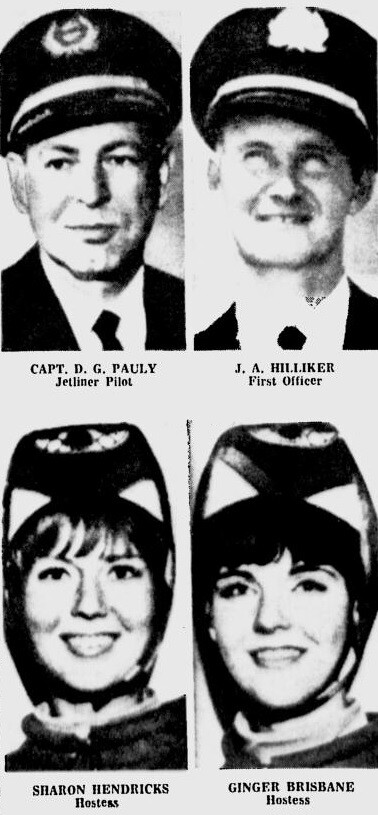
Don Pauly had expressed concerns over the weather in Kansas City, particularly in regards to the cold front with storms along it. Pauly had a conversation with another Braniff pilot who flew in from Chicago about the storms, who gave Pauly this warning:
I told him this was a solid line of very intense thunderstorms with continuous lightning and no apparent breaks, as long and mean a one as I'd seen in a long time and I didn't feel the radar reports gave a true picture of the intensity.
Flight 250 took off from Kansas City at 10:55 p.m. where they were advised to remain at 5,000 feet. Once the flight got 12 miles north of Kansas City, air traffic control was transferred to the Kansas City Air Traffic Control, who gave clearance for the plane to ascend to 20,000 feet. However, the pilot wished to maintain 5,000 feet and deviate to the left of course to avoid the storm. At 11:03, the Kansas City Air Traffic Controller gave them permission to maintain 5,000 feet and deviate to the left of course.
At 11:06, Flight 250 was transferred to the Chicago Air Traffic Control Center which continued with the 5,000 altitude. Soon, Flight 250 came in contact with Braniff Flight 255, who had just departed Omaha heading south. After exchanging weather information, Flight 255 ascended up to 17,000 feet and mentioned moderate turbulence. Flight 250 decided to maintain their 5,000 feet and ceased talking to Flight 255 at 11:08:30, this was the last official transmission received from Flight 250.
The final moments of Flight 250 were recorded using the Cockpit Voice Recorder, which curiously enough had only been mandated in planes that year. The investigation into the crash of Braniff Flight 250 would be one of the first crash investigations to use the cockpit voice recorder.

At 11:12 p.m., around 300 witnesses in Richardson County suddenly reported a bright ball of orange light in the sky descending onto the Barada Hills below. One such witness was the Schawang family, who were driving home that night when they saw it. Little did they know that it was a commercial airline crash, and it just landed in their soybean field.
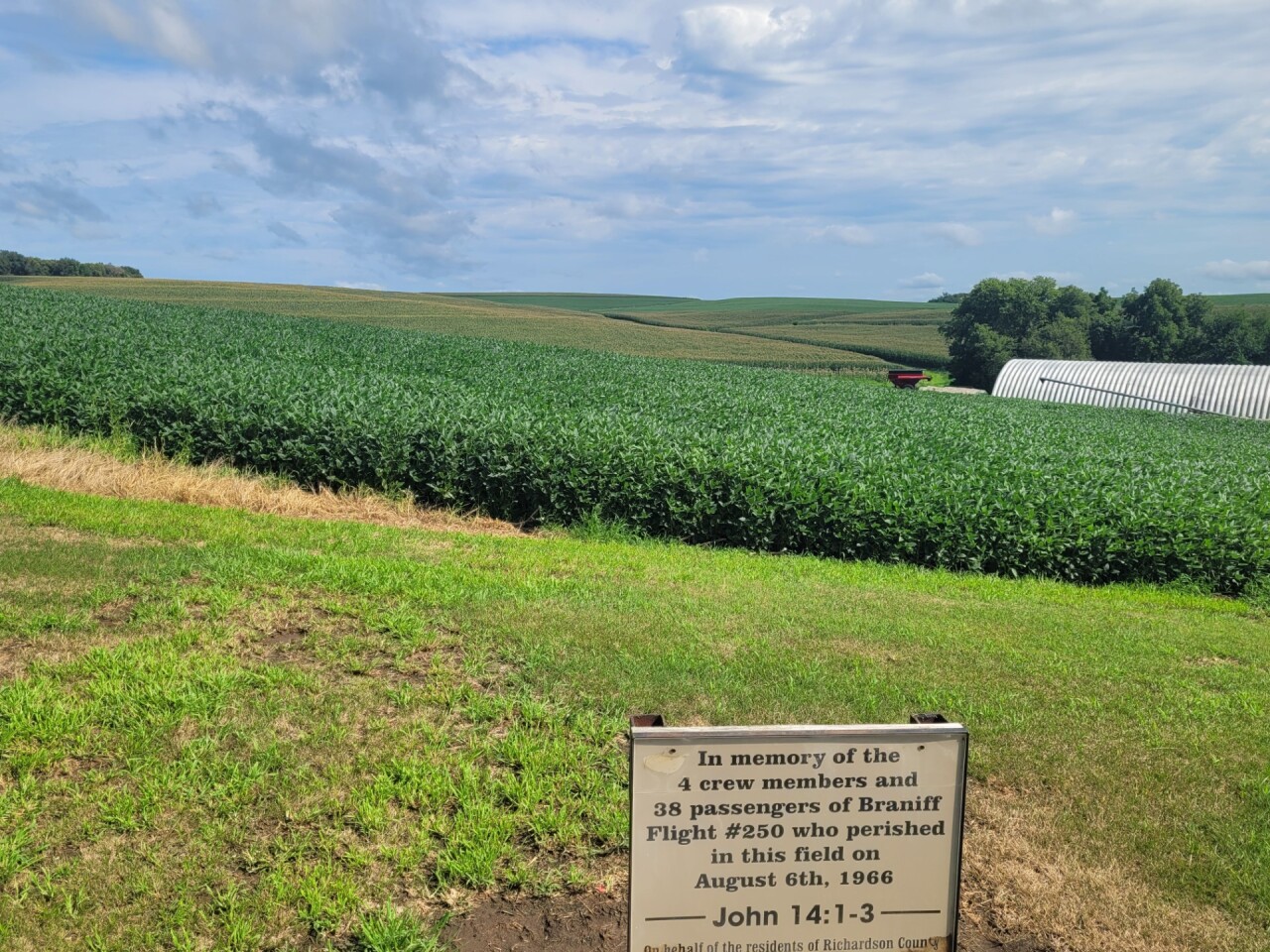
Witnesses reported the plane flew into a roll cloud. Today, we know roll clouds are associated with the outflow of a thunderstorm. Outflows are usually denoted by gusty winds and turbulent skies. It was likely the plane hit the extreme turbulence caused by the outflow boundary, which tore apart the plane before it even reached the rain. The right wing of the aircraft was separated from the plane in the air, and the rest of it fell into the Schawang's soybean field.
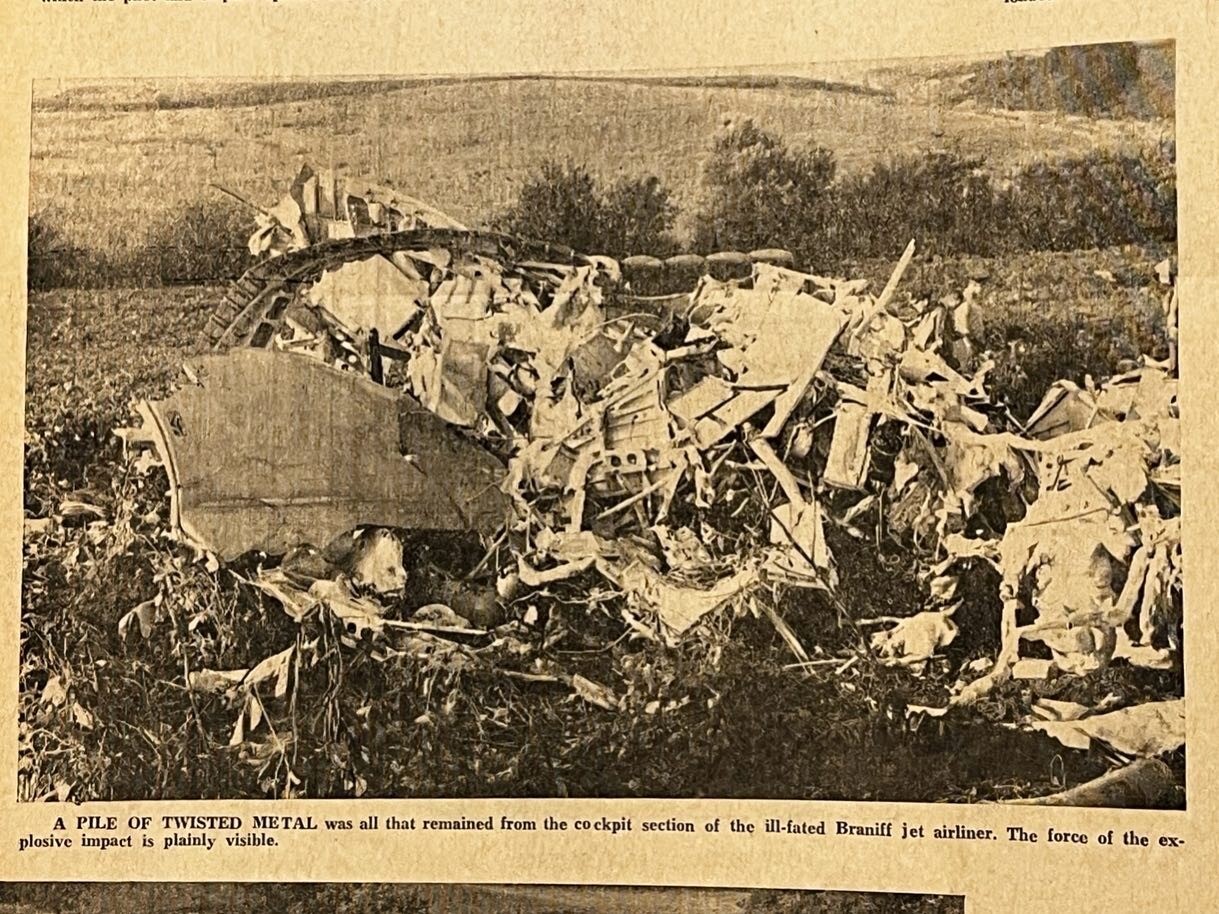
INVESTIGATION AND AFTERMATH
In the immediate hours after the crash, the Schawang residence was home to hundreds of people investigating. While the Schawangs made coffee for the investigators, media, sightseers, family members of passengers, and more, investigators got to work. The soybean fields were scoured for many smaller parts, investigators took witness statements, sent back airplane parts for analysis, and more.
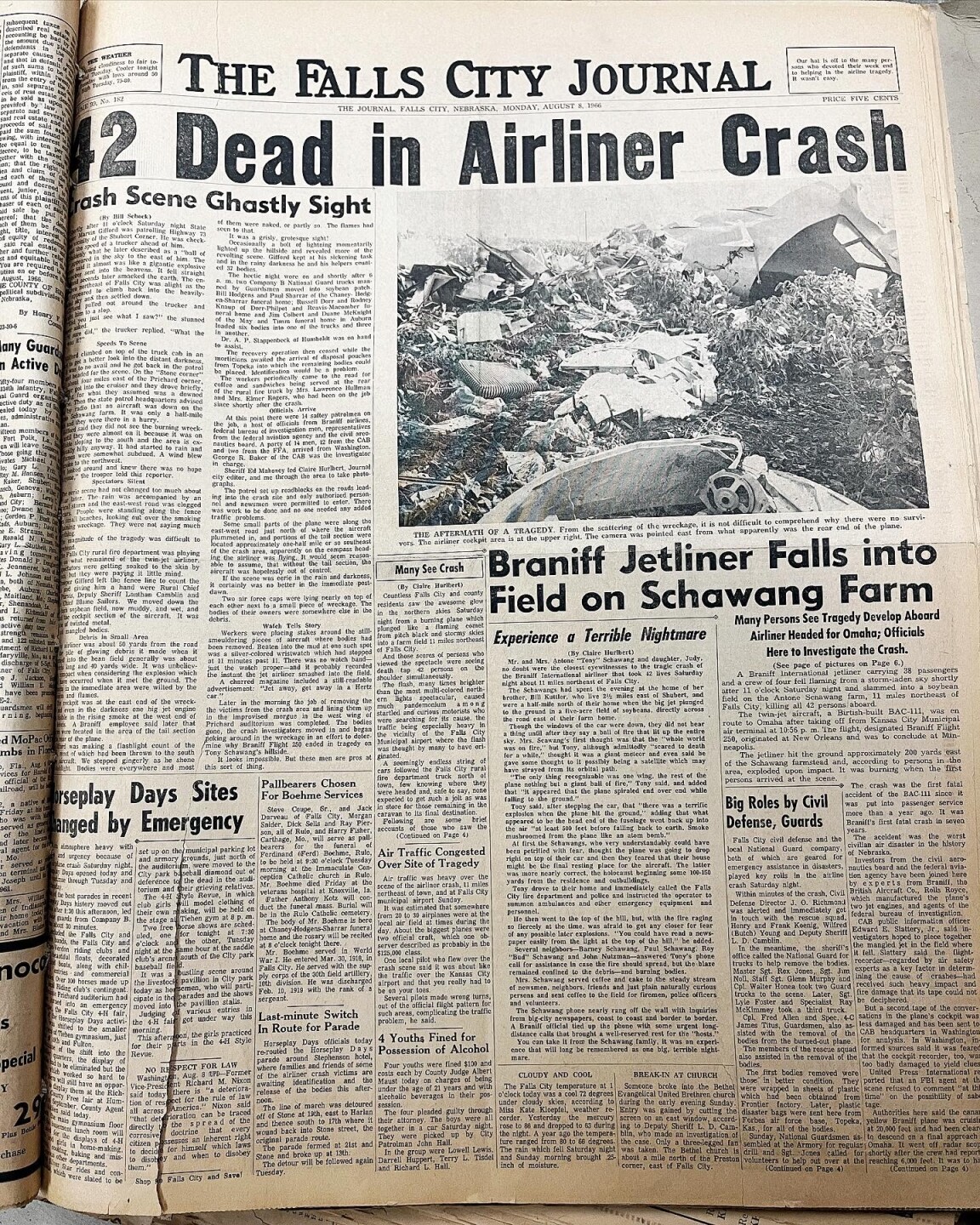
Tragically, what became very clear upon the wreckage was the fact that there would be no rescue missions. All 42 people on board lost their lives on the flight. To this day, it is the deadliest aviation disaster in Nebraska state history.

After reviewing the manuals that Braniff had for weather conditions and flight, it showed that avoidance of thunderstorms should happen at all costs. However, given the lengthy nature of the squall line, it would be impossible for Braniff Flight 250 to avoid going into the storm. There was also some miscommunication or lack of communication between Flight 250 and the dispatchers. For example, other Braniff flights had either significantly altered their course or delayed flights due to the weather. However, this information was never passed along to Flight 250 as it was deemed too irrelevant at the time.

In the coming days and weeks, it became apparent the chief cause of the crash, was the weather. Flight 250 encountered major turbulence once it passed the outflow that it tore the wing off and sent it towards Earth. The National Transportation Safety Board Accident Report stated the probable cause was:
The Board determines that the probable cause of this accident was inflight structural failure caused by extreme turbulence of the aircraft in an area of avoidable hazardous weather.
In the years to follow, stricter guidelines about certain weather conditions and aviation were laid out. Some of this is due to the work of Dr. Ted Fujita, who alongside creating the F-scale used to rate tornadoes, also investigated plane crashes and microbursts. Braniff Flight 250 was Ted Fujita's first plane crash investigation. He determined that the downbursts associated with the outflow of the thunderstorm caused the crash, as detailed in his lengthy report.
Unfortunately, these new guidelines would not save another Braniff flight two years later which crashed due to a thunderstorm. On May 3, 1968, Braniff Flight 352 was flying from Houston to Dallas when they flew into a thunderstorm. The pilots realized their mistake flying into the thunderstorm and attempted to make a 180° turn, but turbulence tore the plane apart and it crashed. 85 people lost their lives, including Texas Representative Joseph Lockridge. This was the second Braniff plane to go down due to weather in two years and certainly soured their reputation in the eyes of the public.
However, Braniff was able to ride the storm. By the late 1970s, the Airline Deregulation Act threw Braniff into financial trouble. By 1982, the company was going bankrupt and would cease operations later that year.
The lessons learned from Nebraska's deadliest aviation accident still lives on today, as it brought about new guidelines and changes in how pilots handle the weather going forward. Nowadays, aviation is one of the safest forms of travel, in part due to the mistakes that came before that shaped the way the airline industry operates.
In 2006, a memorial was placed on the soybean field outside of Falls City where the plane landed. It commemorates those lost. In 2016, on the 50th anniversary of the accident, a memorial service was held in Falls City which was attended by nearly 100 people. Of those in attendance were reporters and family members of those deceased. The memorial still stands for those wishing to visit today, it's located off a county road just 7 miles northeast of Falls City.





